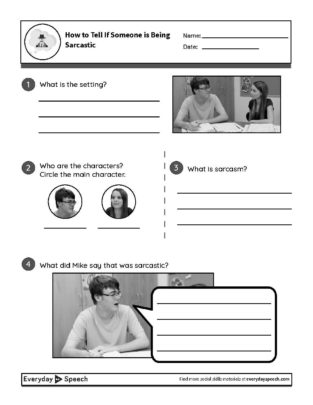Try the no-prep way to teach Using Humor & Sarcasm
Take the prepwork out of teaching essential social-emotional skills with Everyday Speech! Subscribe to access step-by-step curriculum and over 1,000 videos, games, and more.

Preview an SEL skills lesson: Using Humor & Sarcasm

[INTRODUCTION – animated scene]
Narrator: Sarcasm is when a person says something but really means the opposite.
Girl: (spills drink on the table) I love when that happens.
Narrator: Sarcasm is a type of disguised thought. Understanding sarcasm can be difficult and confusing.
Boy: (internal thought) Why would she love spilling her milk?
Narrator: Sometimes, a person uses sarcasm with a friend to be funny. You can tell when someone is being sarcastic by listening to their tone of voice. They might also stress one word in a sentence. This means saying one word a little louder than the others. As a listener, you could also think about the words the speaker uses and think about the situation. Does it make sense? Last, read people’s mood by looking at their facial expression. Do their eyes or mouth show hint of a smile or laughter? Are they rolling their eyes or looking smug? These are common facial expressions people have when being sarcastic.
[SKILLS]
Narrator: The skills we use to figure out if someone is using sarcasm are:
(1) Listen to the person’s tone of voice
(2) Think about the words they use and if they fit the situation
(3) Read the person’s mood.
If you’re still not sure, you can always ask the person if they are being sarcastic.
Let’s watch Alessandra use these skills to figure out if Mike is using sarcasm.
[SCENE 1 Classroom – Alessandra and Mike are working together on a table]
Alessandra: Thanks for picking up the extra work. It’s too bad Emma was sick, but it was nice of you to help with her part.
Mike: Yeah. I didn’t feel like getting a full night’s sleep anyway.
Alessandra: (internal thought) That’s an odd thing to say. Mike doesn’t like sleeping? I love sleeping! Maybe he means the opposite of what he’s saying?
Mike: I just wanted some more work to do. I can’t just sit around having fun all the time.
Alessandra: (internal thought) That’s another funny thing to say. His voice sounded all different than how he usually talks, and he held out the word ‘all’ when he said “all the time”. It would make sense if he meant the opposite here. I bet he’s being sarcastic!
Alessandra: I know. That would be too easy! Anyway, thanks. I really appreciate it.
Mike: No problem. It’s really not a big deal.
Alessandra: (internal thought) Now that time he wasn’t joking. He was being sincere. His voice sounded normal and his face didn’t show any signs of laughing.
Narrator: Alessandra used the steps and figured out that Mike was being sarcastic and that he was saying the opposite of what he meant. First, she thought about the words he said and thought about the situation, then she listened to Mike’s tone of voice. She also read his mood. She looked at his facial expression and noticed he was just barely smiling. When Alessandra put all the clues together, she figured out that Mike was being sarcastic. This helped her know what to say back and how to keep the conversation going.
[WHAT DID WE LEARN]
Narrator: So, what did we learn? It can be confusing and uncomfortable if you aren’t sure when someone is being sarcastic. The skills we use to figure out if someone is using sarcasm are:
(1) Listen to the person’s tone of voice.
(2) Think about the words they use and if they fit the situation.
(3) Read the person’s mood.
Remember, if you’re still not sure, you can always ask the person if they are being sarcastic.
Try Everyday Speech free for 30 days to see all our videos and their companion activities and games!





